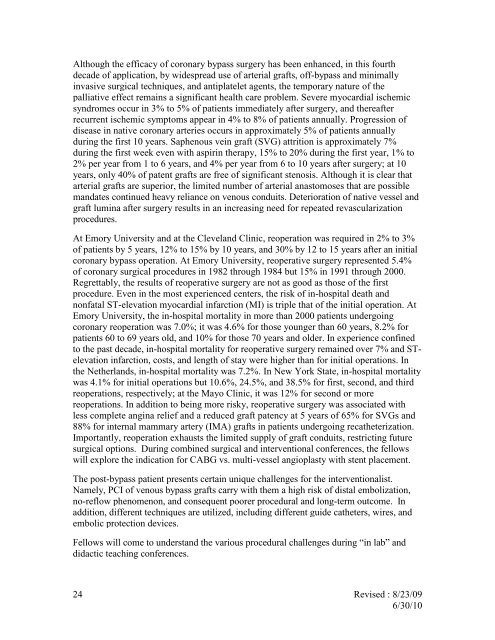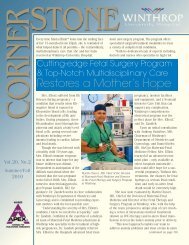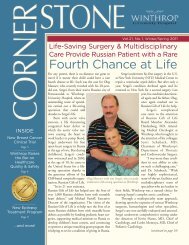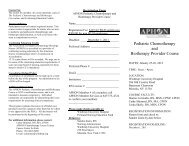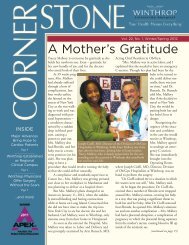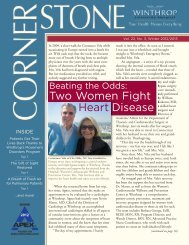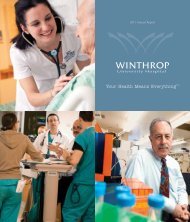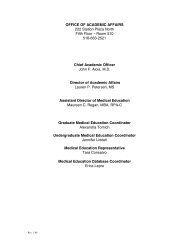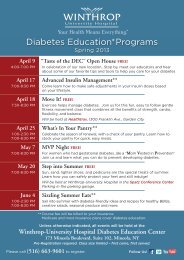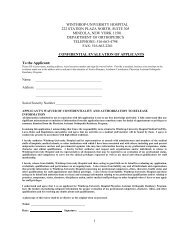interventional cardiology fellowship curriculum - Winthrop University ...
interventional cardiology fellowship curriculum - Winthrop University ...
interventional cardiology fellowship curriculum - Winthrop University ...
Create successful ePaper yourself
Turn your PDF publications into a flip-book with our unique Google optimized e-Paper software.
Although the efficacy of coronary bypass surgery has been enhanced, in this fourth<br />
decade of application, by widespread use of arterial grafts, off-bypass and minimally<br />
invasive surgical techniques, and antiplatelet agents, the temporary nature of the<br />
palliative effect remains a significant health care problem. Severe myocardial ischemic<br />
syndromes occur in 3% to 5% of patients immediately after surgery, and thereafter<br />
recurrent ischemic symptoms appear in 4% to 8% of patients annually. Progression of<br />
disease in native coronary arteries occurs in approximately 5% of patients annually<br />
during the first 10 years. Saphenous vein graft (SVG) attrition is approximately 7%<br />
during the first week even with aspirin therapy, 15% to 20% during the first year, 1% to<br />
2% per year from 1 to 6 years, and 4% per year from 6 to 10 years after surgery; at 10<br />
years, only 40% of patent grafts are free of significant stenosis. Although it is clear that<br />
arterial grafts are superior, the limited number of arterial anastomoses that are possible<br />
mandates continued heavy reliance on venous conduits. Deterioration of native vessel and<br />
graft lumina after surgery results in an increasing need for repeated revascularization<br />
procedures.<br />
At Emory <strong>University</strong> and at the Cleveland Clinic, reoperation was required in 2% to 3%<br />
of patients by 5 years, 12% to 15% by 10 years, and 30% by 12 to 15 years after an initial<br />
coronary bypass operation. At Emory <strong>University</strong>, reoperative surgery represented 5.4%<br />
of coronary surgical procedures in 1982 through 1984 but 15% in 1991 through 2000.<br />
Regrettably, the results of reoperative surgery are not as good as those of the first<br />
procedure. Even in the most experienced centers, the risk of in-hospital death and<br />
nonfatal ST-elevation myocardial infarction (MI) is triple that of the initial operation. At<br />
Emory <strong>University</strong>, the in-hospital mortality in more than 2000 patients undergoing<br />
coronary reoperation was 7.0%; it was 4.6% for those younger than 60 years, 8.2% for<br />
patients 60 to 69 years old, and 10% for those 70 years and older. In experience confined<br />
to the past decade, in-hospital mortality for reoperative surgery remained over 7% and STelevation<br />
infarction, costs, and length of stay were higher than for initial operations. In<br />
the Netherlands, in-hospital mortality was 7.2%. In New York State, in-hospital mortality<br />
was 4.1% for initial operations but 10.6%, 24.5%, and 38.5% for first, second, and third<br />
reoperations, respectively; at the Mayo Clinic, it was 12% for second or more<br />
reoperations. In addition to being more risky, reoperative surgery was associated with<br />
less complete angina relief and a reduced graft patency at 5 years of 65% for SVGs and<br />
88% for internal mammary artery (IMA) grafts in patients undergoing recatheterization.<br />
Importantly, reoperation exhausts the limited supply of graft conduits, restricting future<br />
surgical options. During combined surgical and <strong>interventional</strong> conferences, the fellows<br />
will explore the indication for CABG vs. multi-vessel angioplasty with stent placement.<br />
The post-bypass patient presents certain unique challenges for the <strong>interventional</strong>ist.<br />
Namely, PCI of venous bypass grafts carry with them a high risk of distal embolization,<br />
no-reflow phenomenon, and consequent poorer procedural and long-term outcome. In<br />
addition, different techniques are utilized, including different guide catheters, wires, and<br />
embolic protection devices.<br />
Fellows will come to understand the various procedural challenges during ―in lab‖ and<br />
didactic teaching conferences.<br />
24 Revised : 8/23/09<br />
6/30/10


